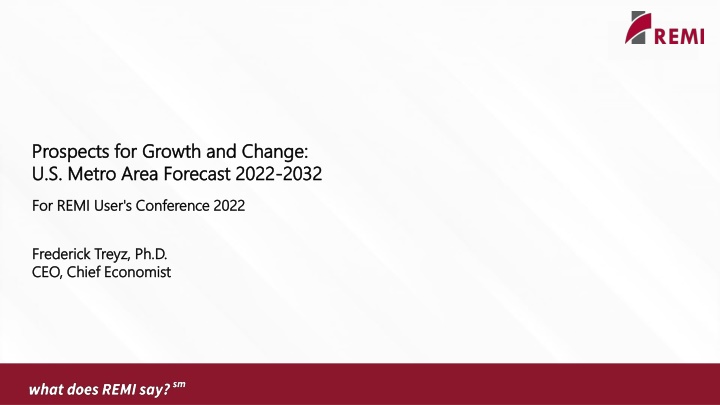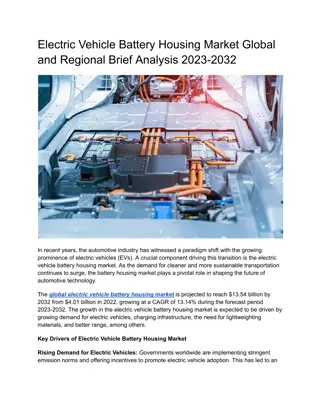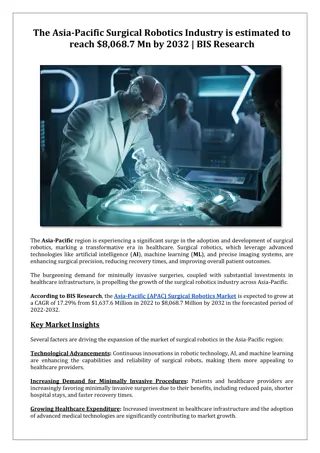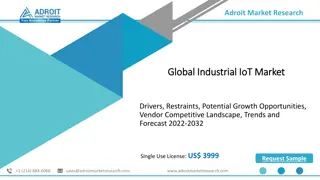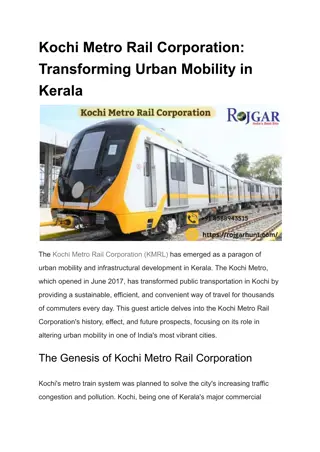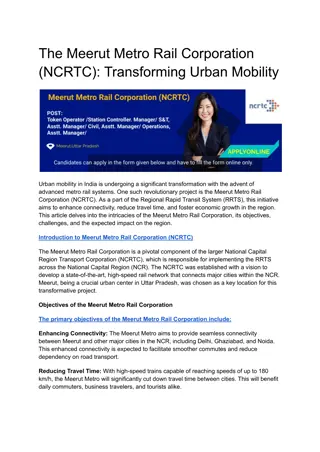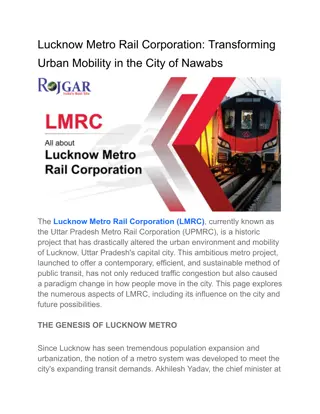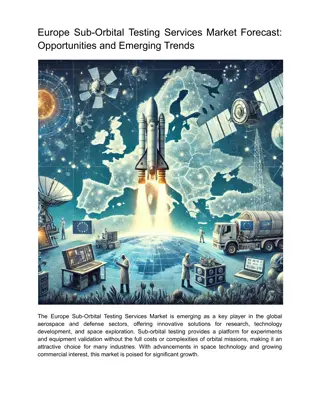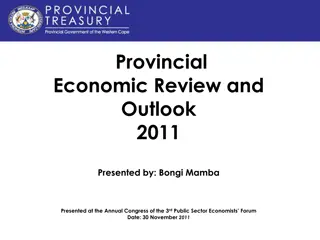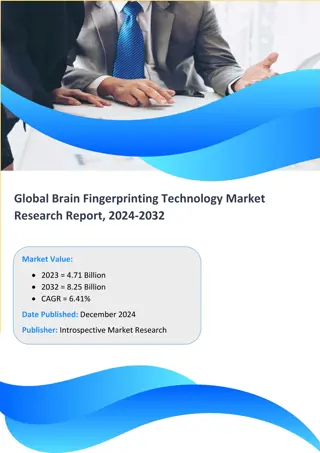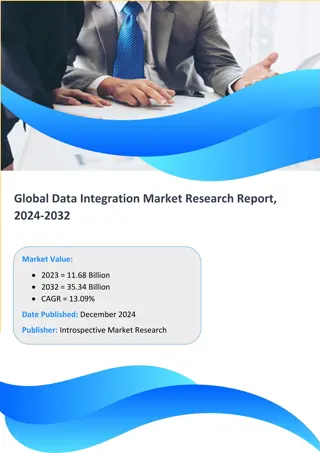U.S. Metro Area Forecast 2022-2032: Economic Outlook & Policy Analysis
Explore the U.S. Metro Area Forecast for 2022-2032 presented by REMI at the User's Conference. Gain insights into national economic context, regional demographics, and economic modeling to understand potential policy challenges. Discover forecasts for employment, population, labor force, and GDP, along with industry-specific employment projections. Learn about REMI's methodology, which combines authoritative sources and local expertise to provide transparent and adjustable forecasts.
Download Presentation

Please find below an Image/Link to download the presentation.
The content on the website is provided AS IS for your information and personal use only. It may not be sold, licensed, or shared on other websites without obtaining consent from the author.If you encounter any issues during the download, it is possible that the publisher has removed the file from their server.
You are allowed to download the files provided on this website for personal or commercial use, subject to the condition that they are used lawfully. All files are the property of their respective owners.
The content on the website is provided AS IS for your information and personal use only. It may not be sold, licensed, or shared on other websites without obtaining consent from the author.
E N D
Presentation Transcript
Prospects for Growth and Change: Prospects for Growth and Change: U.S. Metro Area Forecast 2022 U.S. Metro Area Forecast 2022- -2032 2032 For REMI User's Conference 2022 For REMI User's Conference 2022 Frederick Frederick Treyz CEO, Chief Economist CEO, Chief Economist Treyz, Ph.D. , Ph.D.
Agenda National Economic Context National Economic Context Regional Demographics and Economics Economic Modeling as a Framework Policy Challenges
Introduction REMI is a national and regional economic forecasting and policy analysis model Our baseline forecasts are developed using a well-defined and transparent methodology, based on REMI structural economic and demographic equations, and national macroeconomic projections primarily from the U.S. Bureau of Economic Analysis and the Congressional Budget Office The forecast can be adjusted to reflect local expertise, such as: land use constraints, planned economic development (e.g. a new factory); potential scenarios such as a recession; or the effect of policy changes. We present the default forecast for a transparent methodology that incorporates assumptions from authoritative sources, in particular the BEA and CBO.
National Economic Context REMI is a Top-Down/Bottom-Up Methodology BLS: I-O Tables projected-2031, Employment by Industry Projection-2031, Labor Force Participation Rates through 2031 Census: Fertility rates, survival rates, international migration RSQE (short-term): GDP, Personal Income, Employment Long-term forecast: Congressional Budget Office (CBO)
Table 1: US Economic Forecast Summary 2022-32 2022-2032 % Change 2022 2032 Category Units 205,289 212,296 3% Total Employment Thousands (Jobs) 332,960 350,338 5% Population Thousands 164,280 174,421 6% Labor Force Thousands $25,110 $29,553 18% Gross Domestic Product Billions of Fixed (2012) Dollars
Table 2: US Employment Forecast by Industry 2022-32 2022-2032 Change (Difference in Employment)* 7,007 49 31 -61 401 123 -182 -1,853 485 -91 -206 271 1,290 -92 2022-2032 Change (%) 3.4% 4.8% 3.3% -10.0% 3.7% 0.8% -2.7% -9.8% 4.8% -2.6% -1.9% 2.9% 8.3% -3.2% Industry All Industries Forestry, fishing, and hunting Mining Utilities Construction Manufacturing Wholesale trade Retail trade Transportation and warehousing Information Finance and insurance Real estate and rental and leasing Professional, scientific, and technical services Management of companies and enterprises Administrative, support, waste management, and remediation services Educational services; private Health care and social assistance Arts, entertainment, and recreation Accommodation and food services Other services (except public administration) State and Local Government Federal Civilian Federal Military Farm 2022* 205,289 1,024 966 605 10,951 14,514 6,624 18,968 10,066 3,495 10,985 9,418 15,569 2,917 2032* 212,296 1,073 998 545 11,353 14,637 6,442 17,114 10,551 3,404 10,779 9,689 16,859 2,825 12,682 13,403 721 5.7% 4,911 23,731 4,340 14,533 11,445 19,799 3,073 1,854 2,820 5,299 26,124 5,261 15,380 12,185 20,619 3,133 1,874 2,750 388 2,393 921 847 740 820 60 20 -70 7.9% 10.1% 21.2% 5.8% 6.5% 4.1% 2.0% 1.1% -2.5%
Agenda National Economic Context Regional Demographics and Economics Regional Demographics and Economics Economic Modeling as a Framework Policy Challenges
Regional Demographics and Economics Demographics: Age structure Amenities/quality of life International migration Cost of living Employment: Growing, productive industries; Strong industry clusters
Figure 1: Metropolitan Population Forecast (2022-2032 % Change) US Total 5.2% New York-Newark-Jersey City, NY-NJ-PA -2.0% Los Angeles-Long Beach-Anaheim, CA 2.0% Chicago-Naperville-Elgin, IL-IN-WI 1.5% Dallas-Fort Worth-Arlington, TX 12.7% Houston-The Woodlands-Sugar Land, TX 5.9% Washington-Arlington-Alexandria, DC-VA-MD-WV 9.0% Philadelphia-Camden-Wilmington, PA-NJ-DE-MD 3.6% Atlanta-Sandy Springs-Alpharetta, GA 8.9% Miami-Fort Lauderdale-Pompano Beach, FL 13.5% Phoenix-Mesa-Chandler, AZ 15.8% Boston-Cambridge-Newton, MA-NH 7.3% Riverside-San Bernardino-Ontario, CA 3.0% San Francisco-Oakland-Berkeley, CA 8.6% Detroit-Warren-Dearborn, MI 1.5% Seattle-Tacoma-Bellevue, WA 13.6% Minneapolis-St. Paul-Bloomington, MN-WI 6.1% San Diego-Chula Vista-Carlsbad, CA 4.8% Tampa-St. Petersburg-Clearwater, FL 13.4% Denver-Aurora-Lakewood, CO 11.5% Baltimore-Columbia-Towson, MD 5.5% Rest of U.S. 4.8% -4% -2% 0% 2% 4% 6% 8% 10% 12% 14% 16% 18%
Figure 2: Metropolitan Employment Forecast (2022-2032 % Change)
Figure 3: Metropolitan Real Disposable Income per Capita Forecast (2022-2032 % Change)
Figure 4: Metropolitan Growth Matrix: GDP vs. Population Growth (2022-2023) Category 3 Category 3
Figure 5: Metropolitan Growth Matrix: Employment vs. Population Growth (2022-2023) Category 3 Category 3
Agenda National Economic Context Regional Demographics and Economics Economic Modeling as a Framework Economic Modeling as a Framework Policy Challenges
Economic Modeling as a Framework National Forecast Assumptions Productivity: increases GDP, but fewer workers needed Demographics: Immigration, birth rates, labor force participation Regional Housing Price and Land-Use Constraint Assumptions Amenities and Quality of Life Urban Hierarchy Future of Work
Agenda National Economic Context Regional Demographics and Economics Economic Modeling as a Framework Policy Challenges Policy Challenges
Policy Challenges Political Economic Context Aging and slowing population growth U.S. debt at 120% of GDP; difficult to sustain Zero sum game and populism Government spending 36% of GDP Economic growth 1.8% depends on public and private sector
Figure 6: Population by Working Age and Other Cohorts (US Total) Category 3 Category 3
Figure 7: Population by Region by Age Cohort (New York City) Category 3 Category 3
Q&A Thank you for attending! For more information, please contact info@remi.com
